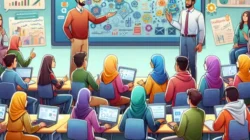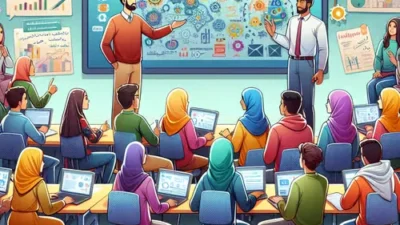Introduction
Who would have imagined that the COVID-19 pandemic, which struck the world in early 2020, would alter the way we educate and learn? Millions of educators and learners worldwide were forced to use the internet to learn from home in a short period of time.
Despite being challenging and perplexing at first, this experience made us realize how beneficial technology can be for education, particularly for language learning. After almost four years, we now require a more improved and focused strategy to increase the efficacy of online language learning.
Online language learning is becoming a new kind of instruction that requires constant improvement rather than being a last resort. Learning a language necessitates extensive contact, ongoing speaking practice, and active student participation, in contrast to other disciplines that can be taught through traditional lectures.
As a result, teaching a language online is far more difficult and calls for a unique approach that differs from traditional classroom instruction.
Teachers must create innovative teaching strategies in light of the swift advancement of technology and shifts in the worldwide viewpoint on education. In addition to using technology as a tool, this approach may design a learning environment that is relevant, engaging, and suitable for every learner.
This shift necessitates a thorough comprehension of the traits of successful online education as well as tactics that may be modified to accommodate different student learning preferences in the digital realm.
In the Current Digital Era, There is a High Need for Online Learning Platforms
Online language learning differs from traditional classroom instruction in several ways. Students must be able to practice the four language skills—speaking, listening, reading, and writing—in addition to comprehending the theory when learning a language. The biggest problem in online education is how to give students enough chances to develop meaningful and authentic communication.
Teachers must create adaptable, individualized, and responsive learning experiences if they want to take a student-centered approach to online language instruction. This differs from the previous approach, in which the instructor served as the focal point of instruction. In this new approach, the teacher’s role shifts to that of a companion who assists students in developing their own knowledge via inquiry, teamwork, and introspection.
There are countless chances to design instruction that meets each student’s needs thanks to digital technology. Based on each student’s progress, intelligent learning systems can modify the content, pace, and teaching strategies. Artificial intelligence, virtual reality, and gamification are beginning to be applied to make learning more interesting and successful.
However, learning will be superficial and pointless if advanced technology is used without proper teaching techniques. Successful methods must incorporate technology with tried-and-true teaching techniques, consider the cultural background of the students, and offer enough assistance to foster critical thinking.
Online Learning Methods as of Right Now
The situation of online language learning at the moment is not entirely clear. On the one hand, numerous educational institutions have effectively incorporated technology into innovative online language learning initiatives. Special language learning apps and platforms like Zoom and Google Classroom have grown to be significant components of the educational landscape. On the other hand, there are still a lot of issues with its application.
The disparity in access to technology is one of the primary obstacles. Not every kid has the same access to a reliable internet connection and technology. Because of this, the quality of education varies, and pupils from low-income families are frequently left behind. Furthermore, not all educators possess the digital abilities necessary to create and carry out successful online courses.
Read more: The Importance of Education for The Future
Another significant issue is the phenomena known as “Zoom fatigue” or online learning weariness. When learning online, students report feeling more alone, less motivated, and less able to concentrate. Lack of social interaction in a virtual setting has an impact on language learning’s emotional component, which is crucial for improving communication abilities.
Online Learning Systems’ Current Status and Effects
a. Benefits
The pandemic has spurred innovation in teaching strategies and increased the use of educational technology. Many educators who once disapproved of technology are now more willing and innovative in their use of it. Additionally, schools are finding it easier to collaborate globally, which creates opportunity for more extensive linguistic and cultural exchange. high adaptability.
b. Adverse Effects
Disparity in income, Low-income students are frequently left behind because they cannot afford to use technology, do not develop their soft skills, Social and interpersonal communication abilities do not develop to their full potential. mental exhaustion, Students who spend too much time staring at the screen become extremely tired.
Solutions for Online Learning Systems in the Current Digital Age
A comprehensive strategy that blends innovative technology with sound teaching practices is required to overcome these obstacles. One potential option is the creation of a blended learning approach, which blends online instruction with a small number of in-person encounters. This paradigm offers flexibility while preserving the social component of learning by fusing the benefits of online education with high-quality face-to-face interaction.
Artificial intelligence and intelligent learning technologies can be used to help customize instruction to meet the needs of individual students. Based on each student’s unique learning style, the system may automatically modify the degree of difficulty, offer candid comments, and suggest learning activities.
To combat loneliness, it’s also critical to establish a robust online learning community. A more meaningful and social learning environment can be produced through virtual language exchange programs, discussion platforms, and cross-country collaborative initiatives. By incorporating game aspects into instructional activities, gamification can be utilized to boost student motivation and engagement.
Training teachers in digital skills ought to be a primary focus. Peer mentoring, communities of practice, and continuous development programs can assist instructors in acquiring the abilities required for successful online instruction.
Governments and educational institutions must also pay close attention to equal access and technology infrastructure. The digital divide can be lessened with the aid of community learning centers, internet connection subsidies, and device support programs.
Programs for government help, subsidies for low-income families’ internet connections and electronic equipment, Community education facilities Establishing collaborative learning areas equipped with technology, collaborations with telecom companies, reasonably priced educational internet bundles, Units of mobile learning devices for mobile learning that deliver technology to isolated locations.
Establishing a virtual community, Establishing lively forums and discussion sites for student engagement, programs for peer-to-peer learning, programs for virtual peer tutoring, Frequent online social events, online talent showcases, sessions in small groups, Learning in small groups can boost engagement.
Use of mixed learning techniques, Using both online and offline resources to cut down on screen time a range of educational formats, Making use of audio learning, podcasts, and combined offline activities scheduled eye rest, organized break time, and physical activity every 30 to 45 minutes.
In Conclusion
The post-pandemic shifts in language acquisition are not merely short-term fixes; rather, they represent significant advances in our knowledge of and approach to language instruction. Innovative, student-focused methods of online language instruction present previously unheard-of chances to develop more individualized, adaptable, and successful learning environments.
Governments, educational institutions, teachers, and students must all be committed to the successful implementation of these strategies. The development of human potential and a thorough comprehension of the fundamentals of effective learning must be balanced with technological investments.
Even if there are still many obstacles to overcome, the pandemic’s initial wave of change offers a solid platform for future innovation. With the correct strategy, online language learning can develop into a new paradigm that is more inclusive, flexible, and pertinent to the demands of the twenty-first century rather than merely serving as a substitute for conventional learning.
Our capacity to keep innovating, adapting, and placing students at the center of all educational endeavors will determine the future of language acquisition. Language proficiency acquired through online platforms will be essential for gaining access to countless international opportunities in a world that is becoming more and more digitally connected.
Author: Rodiyah
Arabic Education Departemen, Faculty of Islamic Studies, Universitas Muhammadiyah Prof Dr Hamka
Supervisor: Dr. Muhammad Iman Sastra Mihajat, Ph.d
Editor: Salwa Alifah Yusrina
Bahasa: Rahmat Al Kafi
Ikuti berita terbaru Media Mahasiswa Indonesia di Google News













